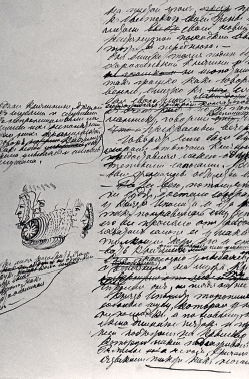The first English-language edition was translated from the French by Clara Bell and published in New York by William S. Gottsberger. The six volumes appeared between 1885 and 1886.
Although Leo Tolstoy’s epic Russian novel is best known for its sheer length, there were many distinctive features that set it apart from previous literary works and insured its towering reputation as one of the greatest books in world literature.
Born into an aristocratic family, Count Lev Nikolayevich Tolstoy (1828–1910) grew up to become a farmer and served in the army in the Crimean War, an experience that planted the seeds of his subsequent pacifism. He later became a moral philosopher, anarchist and writer, and lived with his wife Sophia Tolstaya (1844–1919) and their children at Yasnaya Polyana, his estate 100 miles south of Moscow.
It was a trip to France and Belgium in 1860–61 that shaped Tolstoy’s political and literary destiny. In Paris he met Victor Hugo, whose battle scenes in Les Misérables had a profound influence on War and Peace. Tolstoy’s political philosophy was also engaged by a visit to French anarchist Pierre-Joseph Proudhon, then exiled in Brussels. Tolstoy reviewed Proudhon’s 1861 publication La Guerre et la Paix (War and Peace), whose title he would eventually borrow for his masterpiece.
The product of herculean labour, both by Tolstoy and his wife – who served as his copyist and editor through more than seven drafts – War and Peace was first serialised between 1865 and 1867 in The Russian Messenger magazine under the title The Year 1805. His story was based upon prodigious and painstaking research and his own experience in the Crimean War. After its magazine publication, Tolstoy continued to revise and expand his novel, until it was published in its entirety, at nearly a million words long, in 1869.
War and Peace is an elaborate historical fiction that starts during the reign of Tsar Alexander I and ends in 1813, shortly after Napoléon Bonaparte’s ill-fated march on Moscow – a period a generation before Tolstoy’s birth. The book follows the fortunes of the aristocratic Bolkonsky and Rostov families, who are caught up in this turbulent period of war and peace. The narrative mixes vivid descriptions of real and fictional events with philosophical commentary.
Some critics initially downplayed the work due to its melding of fact and fiction, philosophical commentary, and alternate use of Russian and French in various passages. But all the leading writers of the day, especially the major Russian, French, and English novelists, hailed it as a masterpiece.
When the French translation was published in 1879, Gustave Flaubert exclaimed, ‘What an artist, and what a psychologist!’ Later admirers included Ernest Hemingway, who confessed that Tolstoy had taught him to ‘write about war in the most straightforward, honest, objective and stark way.’ The South African novelist J.M. Coetzee called Tolstoy ‘the exemplary master of authority’, saying he was the most trustworthy storyteller. Others have remarked upon Tolstoy’s use of countless, memorable idiosyncratic details, such as the description of the doomed man who fiddles with his blindfold just before his death.
Tolstoy denied that War and Peace was a novel as such and maintained that the best Russian literature did not conform to standards. He regarded Anna Karenina as his first true novel.
Despite Tolstoy’s own doubts, War and Peace is a staggering achievement. Capturing the grand sweep of history and the private experiences of individuals, this vast novel changed literature and captured the Russian soul.
The first English-language edition was translated from the French by Clara Bell and published in New York by William S. Gottsberger. The six volumes appeared between 1885 and 1886.

A page from Tolstoy’s manuscript, which was painstakingly transcribed by his wife Sophia.